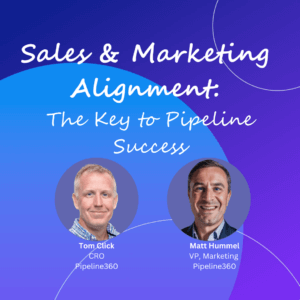In the Tuscan countryside in June, nine marketing leaders from enterprise SaaS businesses across the UK and Europe, came together to discuss and learn about Branded Demand – a marriage of tactics as harmonious and rewarding as the vineyards and olive groves that dot the rolling hillsides of the postcard-perfect destination.
For too long, brand and demand have been considered and executed separately by marketing teams either unaware of the symbiotic nature of the actions and the benefits of unifying them or siloed by internal structures and KPIs that have – perhaps unintentionally – prevented them from re-aligning with the modern buyer’s journey.
Branded Demand – not Brand and Demand
While brand and demand play separate roles – with the former informing and hopefully seducing potential customers, and the latter doing the convincing – those attending the Pipeline360 Brand Summit came to see them as two complimentary ingredients in a campaign cocktail. Good on their own – but better together – and like with all unions, the chances of success increase when the mix and timing are right.
When brand marketing is done right – the right message, at the right time, to the right people – demand inherits momentum and is more effective. This was demonstrated by a summit participant who shared how an OOH campaign led to a closed-won sales opportunity. Demonstrating that a clear brand campaign creates well-informed leads who are mentally already opting-in.
Participants spoke of the struggle of entering new regions, and how brand often became the sole focus, which is short-sighted. While strong foundations are key, the next stage of the journey should always be ready before buyers need it.
Another participant revealed their business is seeing buyers’ journeys of up to two years, which reaffirms the importance of playing the long game and the short, simultaneously.
Marketers must constantly find and educate new potential customers, but at the same time, they need to use demand to keep them engaged and nurtured until they’re ready to buy. Brand is right now. Demand, the future. Combining the two creates faster, more predictable pipeline.
Another challenge identified was budget and how it is allocated. When split between brand and demand, with different KPIs applied, each team works within their silo, and opportunities are lost. Brand is working, for brand. Demand for demand. And the customers’ needs are not being properly met. Teams must align, internally, to properly execute, externally.
Conversely, participants said that when budgets did align, key insights were often lost with teams focusing entirely on what accounts entered the funnel – not what led them there.
When teams work together and are data led, processes can continually be optimised, and ROI becomes increasingly likely.
Different content for different clients
The increasing size of buying groups, now thought to involve upwards of 20 people, meant demand efforts and effectiveness are being diluted, Summit participants said. To be targeted and yet remain effective marketers now need to meet the needs of multiple different personas within the group.
A one-size-fits-all approach won’t work, and the best assets aren’t the best assets for everyone, regardless of how much you spent on them.
Marketing teams need a diverse suite of content – from whitepapers to podcasts and bite-sized explainers – to ensure they can tempt the palettes of buyers who have long since bored of choosing from the predictable menus we’ve laid out for them.
And, ads that look like ads, won’t cut it. Marketers must always add value. Play the game to win – don’t just play along.
Control the narrative – Help clients get the full picture
While the world has been fretting about robots replacing workers since a pesky bug threatened to take down the world of computers in 2000, those at the Summit were taking a more positive approach and spoke of making AI work for them.
With people increasingly using technology to do the leg work for them, rather than relying on search engines to surface content they need to analyse, marketers spoke of the need to ensure any content produced reflected key brand messaging and standards.
So, when AI is asked about your company, the answers it returns are exactly the ones you’d give.
Brand standards over industry benchmarks
While aiming to lead the industry is admirable, focusing excessively on benchmarks instead of personal bests can lead companies to misinterpret positive results as negative. This approach often causes them to lose sight of their own brand and marketing efforts.
To get better, and truly understand what success looks like, companies must rely on their own metrics, rather than trying to keep up with the Joneses; build on their own land, before looking beyond the fence line.
And often, industry standards only tell half the story. Click-through rates are great, but did it result in any new business?
Companies must set their own standards and focus on the stats that really matter vs those that are industry standard.
Manual labour – Time well spent
While sales are struggling with lead flow due to an economy that refuses to grow and marketing teams having less money to spend, teams spoke of having to dig into the data themselves.
But rather than it being viewed as wasted time, Summit participants saw it as a way to get ahead of the curve. Why wait for data to cache, or curse the tech, when you can do the maths now, harvest the insights and optimise plans in real-time.
Participants also adopted a DIY approach when it came to Target Account Lists, suggesting that relying on sales was not best practice. Their focus on sales’ input meant they often had a short-term view.
Savvy marketers should get their hands dirty when it comes to data to identify what Ideal Customer Profile (ICP) accounts are interacting with brand assets, to really determine who the hot leads are.
Getting data right and the right data
Data accuracy was a key concern to Summit participants, but it was driven by the need to perform, rather than compliance fears.
Marketing Qualified Accounts (MQA), rather than Marketing Qualified Leads (MQLs), was the focus in an evolution that mirrors that of the buyer becoming a buying group, and the group being thought of as an account rather than a collection of people.
As always, to execute properly, marketers must target correctly, and in this case, participants believed the focus should shift to MQAs which better reflect required alignments.
Demanding more teamwork
Just like brand and demand go hand-in-hand, Summit participants suggested sales and marketing need to be more aligned and should have joint go-to-market workshops where strategies, goals, and KPIs can be collectively set, so they can be collectively worked towards.
Revisiting an earlier point, it’s crucial for marketing teams to be fully aligned, also. Brand and demand teams must collaborate, even with separate budgets, to optimise and measure the entire buying journey effectively.
These were some of the key topics discussed at our recent Summit with leading marketing experts. In the second half of the year, Pipeline360 will launch the second iteration of our survey, “The State of B2B Pipeline Growth,” to explore the challenges and concerns of 500 US and UK B2B digital and demand marketers. We look forward to understanding the industry’s perspective on these important issues and how Pipeline360 can help companies navigate these challenges.






